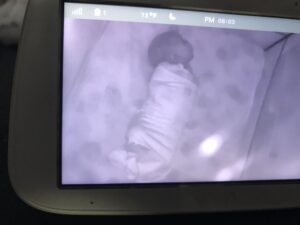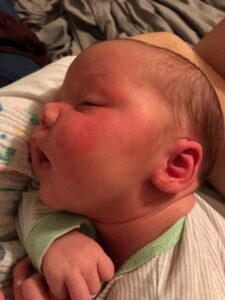I’ve said before that I love all things pregnancy, birth, and babies, so each pregnancy I go into, I know more and more.
By the time we were pregnant with our third baby, I had heard more stories about tongue ties and lip ties, what the signs were a baby might have oral restrictions, and what treatment options were. I wasn’t necessarily paranoid about my baby having those challenges, but I was much more aware and ready to keep my eyes peeled than I was with my other two kids.
Well, that prior knowledge and more open eye out certainly came in handy!
In this post, I’m going to share all about our youngest daughter’s lip and tongue tie, including:
- Signs of my baby’s lip tie and tongue tie the first few days and weeks after she was born
- Signs of my baby’s high palate
- What we did when we suspected our baby had oral restrictions
- What the frenectomy was like and how she (and we!) handled it
And more!
Signs of Our Baby’s Tongue Tie, Lip Tie, and High Palate
It all started right after I gave birth. I pretty quickly noticed Isla’s chin looked a bit receded, but she had literally just come out, so I tried to relax. When I helped her latch to my breast for the first time, she did great on the right side. But when it was time for the left side, she really struggled to latch. We took note and my midwife was helping, but again, this baby was just learning how to nurse, so I was trying to relax and give her time.
She continued to nurse pretty well on the right side, but the left was almost always a struggle to latch well those first couple of days. And it was frustrating! I had already nursed two babies for 18 months and I knew what I was doing. And when a baby gets frustrated and upset it makes it harder to latch, so that left side was frustrating all together. But she would always eventually latch and it was okay.

Within those first couple of days, however, I also noticed my milk wasn’t coming in as quickly as it had with my other two. I knew it could be different for every baby, so I was trying to give myself and her some grace, but it got to a point where she was clearly hungry and my milk wasn’t coming in for her yet. I felt like I was always cluster feeding, then I’d finally get her to fall asleep, and when she woke up we’d repeat.
My oldest had just been diagnosed with cancer about three weeks before Isla was born, so I figured stress probably had something to do with my milk taking longer to come in. I didn’t want to have to give my baby formula if I didn’t have to, but I also didn’t want her to be hungry!
And she was still having wet diapers, but they were starting to go down in number, so I called my midwife.
She said we were still in the “this is still normal for some” zone, but we needed to keep a close eye. So I was counting diapers and timing how long she nursed on each breast, and whenever she was on the right side, I had the haakaa on my left. And any time she was on the left side, the haakaa was on my right; we needed that milk to come in!
And it DID! I’d say 12-24 hours after talking to my midwife, my milk came in just like it was supposed to and baby and mama were very happy.
So fast forward a bit, my milk was in and baby Isla was happy and growing. Nursing was still kind of weird on that left side for about two weeks, but I was able to overcome it by changing the position I nursed her in.
And while she almost always struggled to nurse on the left, nursing was never painful, and again, she was growing really well. Two great signs! But I could still tell something was off, I just didn’t know what exactly.
Then there was a week or two when she was extra fussy in the evenings, especially around feedings. It was like she wanted to nurse, but couldn’t. Or wanted to nurse, but nursing made her feel worse. She was tense and crying a lot, and would really only calm for my husband. This was another red flag to me that something was up.
She also slept in a really strange position in the bassinet, with her head almost cocked back and to the side. And she had the same strange position in the car seat. So after a few tougher evenings, we took her to the chiropractor. We never took our older two when they were babies, but I had gotten great chiropractic care during my pregnancy and knew they worked on infants, so I wanted to try.

She had a few adjustments and they really helped. She wasn’t nearly as fussy in the evenings, she was latching on both sides well, and she looked much more comfortable in her car seat and bassinet.
But I still felt like something was off.
She almost always made a clicking noise while she nursed and no matter how I repositioned her, I couldn’t make it stop. My older two did that very briefly, but I could always reposition them and make it go away, and eventually, the clicking just stopped. But with Isla, nursing her was almost always noisy, no matter what I did, and I knew it just wasn’t supposed to be that way.
She also slept with her mouth open, which I knew to be another red flag.

So the red flags kept coming, and had our oldest not been diagnosed a few weeks prior, we likely would have reached out for help sooner. But to be honest, life was chaotic and we really wanted there to be no problem, so we waited. And I’m not saying that as a regret thing, just sharing that real life happens.
We did bring it up at her pediatrician appointments, and not surprisingly, her pediatrician said there were no ties. And this is not to throw pediatricians under the bus, because they are wonderful. But it is to say that pediatricians aren’t lactation professionals, or nutritionists, or PTs, or OTs, or sleep consultants! So I heard my pediatrician, but wasn’t willing to settle there – I just knew something was wrong.
So when she was around seven weeks old, we finally went digging.
Our Next Steps
I reached out to a pediatric dentist my midwife recommended to us because they specialize in oral restrictions. When I called them, they said their protocol was for you to first start with a lactation professional who was lip and tongue tie savvy. Because again, another sidenote: not all lactation professionals know how to spot lip and tongue ties!
So she gave me a referral to a local lactation group. They would look at our babe, check for ties, help us with positioning and such, and then teach us about the aftercare and how to do the stretches should we get the frenectomy. THEN we’d go to the pediatric dentist, she’d officially diagnose the ties, and then if we were ready, they could do the release at that same appointment.
I reached out to that lactation group, an IBCLC came right to our house, and sure enough, our baby had both a lip and tongue tie – the lip tie wasn’t terrible, but the tongue tie was pretty strong. She also said Isla had a super high palate, which I didn’t really know was a thing.
Now I just want to pause and remind you that I didn’t have any pain while nursing Isla – not once. And she was growing so well! Those are often the first two most common red flags of oral restrictions, and we didn’t have either of them. So again, if you suspect something is up but nursing seems to be going well, there could still be something going on, so keep asking!
When the lactation consultant came over, she did a weighted feed where she weighed Isla in just a diaper before nursing, I then nursed her, and she weighed her again. This helped give us a really clear picture of how she was transferring the milk! I want to say she had gained 4-5 ounces from that weighted feed, mostly from one side, and my IBCLC was shocked, especially given her ties.
And then my mind was blown when the lactation consultant started helping us put it all together.
Her Oral Restrictions Explained
Our IBCLC said that right now, Isla was just kind of riding the wave of my strong letdown and milk supply. She didn’t have to work hard to get the milk, which is why she was growing well. The problem, however, is that soon my supply would start regulating based on what my baby was saying she needed, and because she wasn’t effectively removing that milk, my supply would likely drop, which would slow her weight gain.
Remember how my milk took longer to come in this time around? Sure, stress and just a different baby could have still been a part of it, but much more of a culprit was the fact that Isla’s oral restrictions weren’t allowing her to effectively stimulate that milk production.
And remember that clicking noise that was always happening was because she couldn’t get a solid latch due to those restrictions? She was sucking in air as she was nursing, and sucking in all that extra air can certainly lead to lots of discomfort and/or extra gassiness, so the fussy evenings made sense.
Additionally, the high palate was due in part to the tongue tie and her not being able to rest her tongue on the roof of her mouth while sleeping. I learned that our tongue is a natural palate expander, and it’s supposed to rest on the roof of our mouth while we sleep – with our mouths closed!
So when babies (and older kids and adults) are sleeping with their mouths open, their tongues are sitting at the bottom of the mouth, not doing their job of palate expanding. And when a baby has a tongue tie, that tongue can’t reach the palate to do its job of expanding the palate. Not to mention its job of effectively removing milk. It’s all connected!
And that high palate, plus overall tension from the lip and tongue tie, is what made her sleep in such a strange position. Our palates are the bottom part of our nose, so when palates are high, our nasal airways are smaller – so her funky sleeping position was the best way she could figure out how to breathe!
Everything was finally making sense.
If you’re curious to learn more about these first few weeks of Isla’s life, including her tongue and lip ties symptoms, the ups and downs of her sleep, her growing personality, etc., check out this blog post with a week-by-week recap of the first 16 weeks of her life!
The Frenectomy
We then got Isla’s frenectomy on the calendar, which is when they lasered her lip and tongue ties, and it made a world of a difference. Those fussy evenings were quickly gone and nursing was getting quieter and latching was smooth. We continued with chiropractic care as her body adjusted, and we saw a craniosacral therapist because again, those restrictions and tension in the body are all connected! And that body tension isn’t released simply because the actual frenulum was lasered.
And slowly but surely the funny sleeping position adjusted!
I have to be honest that the frenectomy and the stretches afterward were brutal. The actual release went well, but they swaddle your baby up and you can’t be in the room. It’s thankfully quick, but that part is not easy. They had me nurse her right away when they were done, with a lactation consultant watching and helping if need be, and she nursed well and calmed very easily, which I was so thankful for. But it was an emotional day!
They recommended we give her Tylenol round the clock for the first 24 hours to stay ahead of any pain, so we did. And she really did not seem uncomfortable at all while on the Tylenol, and even once she came off. We were so thankful for that!
But after about 24 hours is when the stretches started. I think it was around six times a day, so really every awake window, and once overnight, we had to do these stretches. She of course screamed, and it was so hard.
The first few days my husband and I tag-teamed it together – one of us would hold her while the other did the stretches. It gave us moral support but also helped us get comfortable doing the stretches. From there we could do them solo, but any time Jason was home, and in the middle of the night, I made him do the stretches. They were just so sad. I don’t think they hurt her, I think she was more angry that our big hands were in her little mouth!
But we were not going to slack on those stretches, because the mouth heals so quickly, and that can be a disadvantage if the ties heal tight again. We were not going to go through this whole process again.
I don’t remember the details, but I want to say we had to do the overnight stretches for about two weeks and the daytime stretches for about four weeks, slowly weaning away from them. We’d send pictures to our lactation consultant and she came back to check on the healing once.
Those stretches were so hard but also so important. Doing exercises for Isla’s tongue and palate was important, too! Just because her tongue tie was now released didn’t mean her tongue knew what to do. It had just missed out on seven weeks of “exercise”, and it’s a muscle – we had to help train it what to do.
And her palate needed sensory input as it wasn’t getting it from her tongue. She had a really strong gag reflex, so we had to practice giving her palate input with our fingers. So another side note here, if no one gives you little exercises to do beyond the frenectomy stretches, ask more, because the tongue needs help learning what to do.
I will also add that almost two years later we’re still working on Isla’s high palate and mouth breathing. She’s also a crazy drooler, which is all connected to her weaker tongue, so not everything is an overnight fix!
Conclusion
“Knowledge is power” when it comes to most things in parenting. You know your baby best and you are their advocate, so simply having an awareness of what’s normal and what might not be so normal is a big deal.
If you see a provider and they tell you everything is fine but you still think something is off, keep digging! And if your baby does end up with an oral restriction and needs a frenectomy, follow your provider’s plan so your baby can thrive!
Also remember that no one expects you to be the lactation professional. You are not expected to have all of the answers. You might miss something, or life might be so hectic that you just don’t or can’t see it. So give yourself grace when it’s hard and lean on your people to help you!
And if you’re curious to learn more, continue our series with the following posts:
- Oral Restrictions Explained by a Lactation Counselor
- How Craniosacral Therapy Helps with Oral Restrictions
- Mouth Breathing and High Palates Explained by a Myofuctional Therapist
With Grace,
Lauren